Vibration Analysis of Euler-Bernoulli Beams Partially Immersed in a Viscous Fluid
Abstract
The vibrational characteristics of a microbeam are well known to strongly depend on the fluid in which the beam is immersed. In this paper, we present a detailed theoretical study of the modal analysis of microbeams partially immersed in a viscous fluid. A fixed-free microbeam vibrating in a viscous fluid is modeled using the Euler-Bernoulli equation for the beams. The unsteady Stokes equations are solved using a Helmholtz decomposition technique in a two-dimensional plane containing the microbeams cross sections. The symbolic software Mathematica is used in order to find the coupled vibration frequencies of beams with two portions. The frequency equation is deduced and analytically solved. The finite element method using Comsol Multiphysics software results is compared with present method for validation and an acceptable match between them was obtained. In the eigenanalysis, the frequency equation is generated by satisfying all boundary conditions. It is shown that the present formulation is an appropriate and new approach to tackle the problem with good accuracy.
1. Introduction
The objective of this paper is to provide an analytical method to calculate the coupled frequencies of vibration of microbeams partially immersed in a viscous fluid. The microbeams are clamped on one edge while the other edge is free.
The motivation of this work is to provide a theoretical model that can be used in the design and interpretation of density and viscosity sensors.
Due to their size and potential for highly sensitive and low cost compact device applications, microstructures are becoming increasingly attractive for sensing applications and have been studied extensively in recent years. Microstructures are commonly used in atomic force microscopy (AFM) to probe surface properties and to measure interfacial forces [1–7], in biological and chemical sensors [8–10]. A precise modeling of the solid-fluid interaction and the determination of the frequency response enable the measurement of the density and the rheological behavior of fluids [11–16]. Reference [16] uses finite element analysis (FEA) method in order to predict the dynamic response of the cantilever beam. This method can be easily applied to the measurement of the fluid viscosity.
For microstructures, fluid viscosity can greatly affect their frequency response. Reference [7] presented a rigorous theoretical model for the frequency response of cantilever beams that are undergoing flexural vibrations and immersed in viscous fluids, which is of particular relevance to applications of the AFM. The knowledge and understanding of the frequency analysis of microbeams are of fundamental practical importance in application to the AFM.
The frequency analysis of a microbeam can be dramatically affected by the properties of the fluid in which it is immersed. Whereas calculation of the natural frequencies in vacuum can be performed routinely, analysis of the effects of immersion in fluid poses a formidable challenge. The modal response of an immersed microbeam can be considerably affected by the properties of fluid. The added mass effect due to the fluid structure interaction can, however, cause considerable variations in natural frequencies. The knowledge and understanding of this viscous fluid-structure coupling are lacking at present.
In this contribution, we investigate the vibrational behavior of microbeams partially immersed in a viscous fluid, which describes the interrelation between the fluid’s density and viscosity. For a viscous fluid problem, the analytical formulation is based upon a convenient decomposition of the velocity field into two contributions, one being related to the scalar potential and the other being the vector potential. The solutions of the differential equations of motion turn out to be complex and can be conveniently treated with the aid of the symbolic software Mathematica. Furthermore, this work investigates the influence of the fluid’s viscosity on the vibrational behavior of the microbeams.
2. Modal Analysis of Beams and Frequency Equation
Modal analysis of elastic immersed structures is needed in every modern construction and should have wide engineering application. In this study, modal analysis is important to predict the dynamic behavior of the submerged beams. It is well known that the natural frequencies of the submerged elastic structures are different from those in vacuum. The effect of fluid forces on the immersed beam decreases the natural frequencies from those that would be measured in the vacuum. This decrease in the natural frequencies is caused by the increase of the kinetic energy of the fluid-beams system without a corresponding increase in strain energy. The Euler-Bernoulli beam is partially immersed inside rectangular fluid domain (Figure 1). Consider a beam of length 3.06·10−2 [m], width 4.6·10−3 [m], and thickness 1.27·10−4 [m] as shown in Figure 1, which corresponds to a model developed in [16]. The interaction between the fluid and the Euler-Bernoulli beams is taken into account to calculate the natural frequencies and mode shapes of the coupled system. The dynamics of each beam portion are treated separately. It is assumed that the beam has aligned neutral axis.
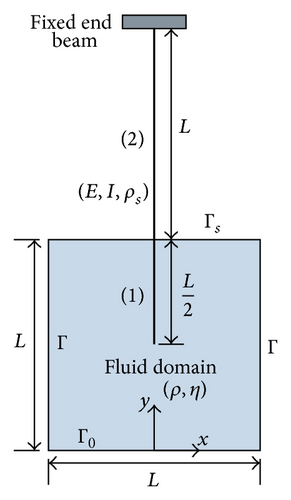
2.1. Mathematical Formulation
2.1.1. Field Expansions
2.2. Method of Solution and Frequency Equation
3. Analytical and Numerical Results and Validation
The model that was developed in Section 2 can be validated by comparing the analytical results to model results calculated using Comsol Multiphysics FEM Simulation Software. This comparison used beams with Young’s modulus being E = 200·109 [Pa], Poisson’s ratio being ν = 0.3, and density being ρ = 9450 [kg/m3]. The fluid used in the rectangular container for which density of 965 [kg·m−3] and dynamic’s viscosity of 0.1 [Pa·s] is assumed.
For coupled vibration analysis of beams partially immersed in a viscous fluid, the accuracy of the present method has been compared with the results obtained with Comsol Multiphysics FEM Simulation Software. The FEM used model had 585039 number of degrees of freedom and was analyzed using the algorithm based on the UMFPACK method [19].
In this paper the comparison of the values of the angular frequency parameter ω is given in Table 1. As one can see from the comparison, very good agreement with those of FEM is obtained.
| Order | Present | FEM | Difference (%) |
|---|---|---|---|
| 1 | 4.90 | 4.86 | 0.82 |
| 2 | 18.18 | 17.91 | 1.50 |
| 3 | 20.26 | 20.01 | 1.24 |
| 4 | 21.11 | 20.86 | 1.19 |
| 5 | 24.68 | 24.50 | 0.73 |
| 6 | 30.48 | 30.20 | 0.92 |
| 7 | 31.59 | 31.44 | 0.47 |
| 8 | 39.24 | 38.91 | 0.84 |
| 9 | 44.68 | 44.51 | 0.38 |
| 10 | 47.65 | 47.31 | 0.71 |
| 11 | 50.20 | 49.72 | 0.96 |
| 12 | 54.68 | 54.02 | 1.22 |
| 13 | 56.10 | 55.33 | 1.39 |
| 14 | 61.47 | 61.25 | 0.35 |
| 15 | 61.90 | 61.36 | 0.88 |
| 16 | 64.57 | 64.15 | 0.65 |
| 17 | 67.29 | 66.72 | 0.85 |
| 18 | 73.47 | 72.99 | 0.65 |
| 19 | 79.63 | 79.21 | 0.53 |
| 20 | 80.06 | 79.42 | 0.80 |
| 21 | 85.67 | 85.41 | 0.30 |
| 22 | 87.58 | 87.09 | 0.56 |
| 23 | 91.33 | 90.85 | 0.52 |
| 24 | 97.44 | 97.10 | 0.35 |
With the derived eigenfrequency equations, natural frequencies ω are calculated in the software Mathematica. To validate the analytical results, the natural frequencies and mode shapes are also computed using Comsol Multiphysics FEM Simulation Software. The natural frequencies are computed directly from determinant of (43).
Table 1 shows the comparison of the first 24 natural frequencies and the corresponding mode shapes of viscous fluid by FEM and the present method (43). The good agreement is observed between the results of the present method and those of FEM and the relative difference (100 × (Present − FEM)/FEM) is ⩽2%. This shows that the algorithm implemented in Comsol Multiphysics [20] software for numerical computation is highly reliable and accurate. Mesh refinement can significantly decrease the relative difference.
The two possible first coupled mode shapes are represented in Figure 2. A very good agreement with Figure 3 of [16] confirms the adequate implementation of the method in the FEM software.
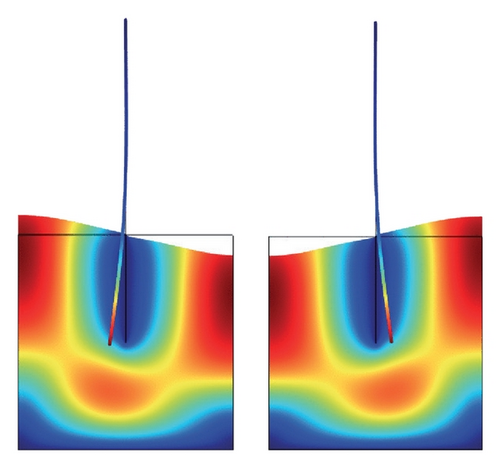
Figures 3 and 4 show the influence of fluid’s viscosity on the odd and even natural frequencies. It is seen that the effect of viscosity is very interesting and decreases the frequency of beams. These figures show also for small fluid’s viscosity that the model is not suitable to describe properly the vibrational behavior of beams immersed in a viscous fluid. In this case, the most appropriate model is the model developed in [21]. In other words, the viscosity terms can be neglected and the resulting model is called inertial coupling [22].
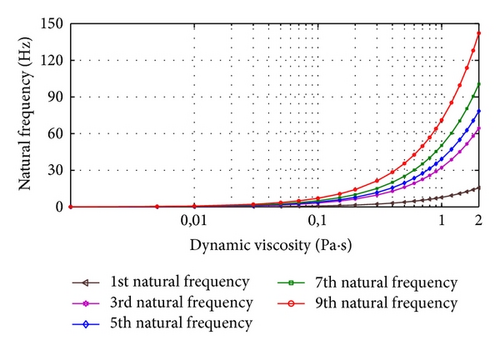
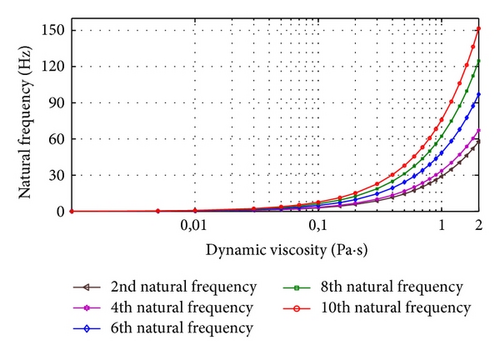
Figures 5(a)–5(f)–8(a)–8(f) obtained by Comsol show the first 24 coupled modal shapes with the corresponding eigenvalues ω. In these figures, solid lines denote streamlines (i.e., Stokes eddies) caused by system boundaries and fluid structure interaction. In addition, the formation of Stokes eddies is not affected by the presence of an obstacle (beam) in the fluid domain. As expected these Stokes eddies increase when the angular frequency is raised like in the case without obstacle. Finally, these Stokes eddies are symmetric with respect to the obstacle.
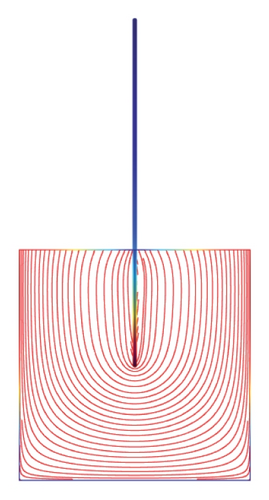
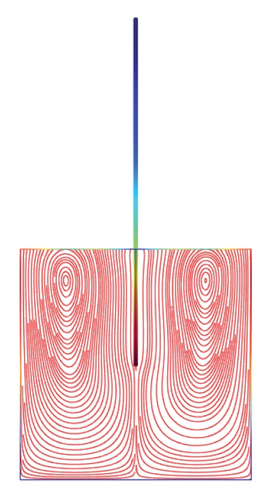
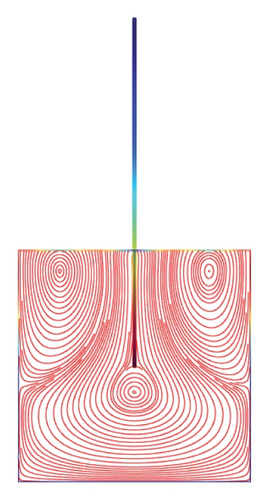

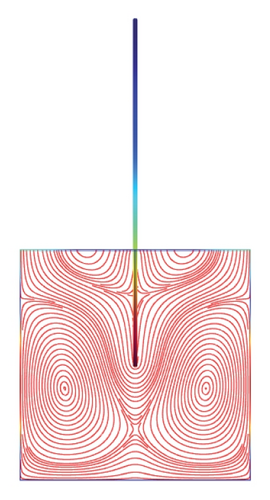

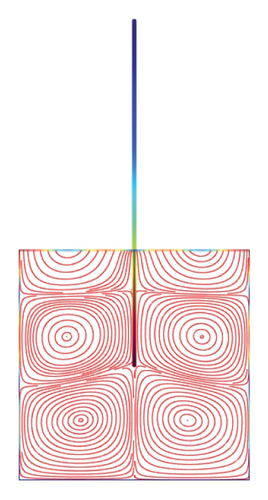
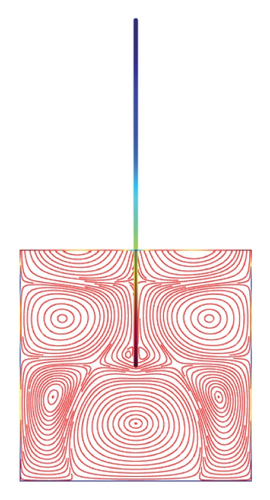
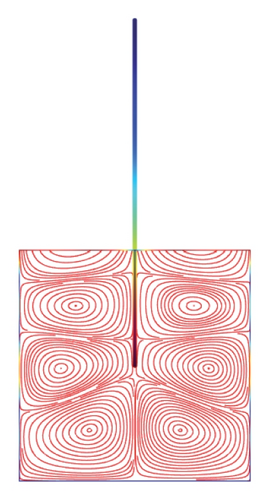
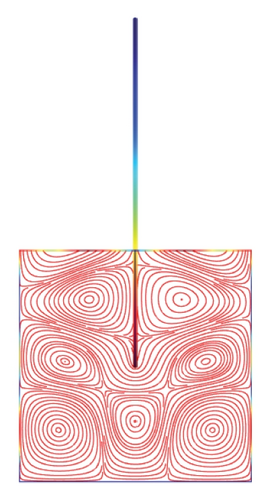
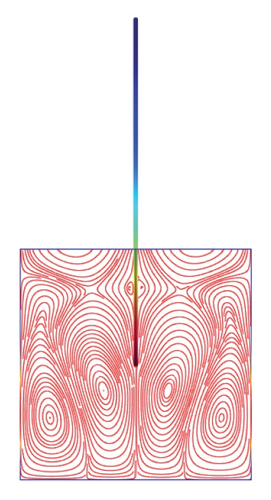
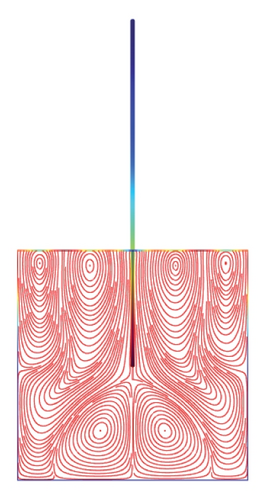
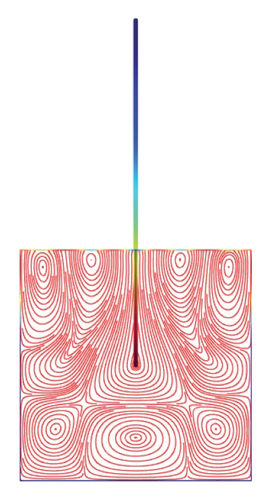
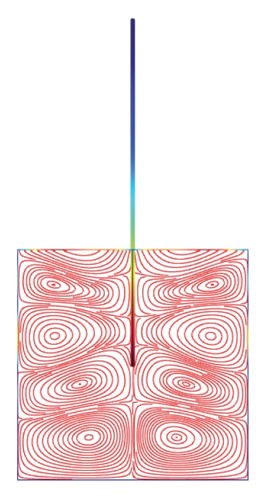
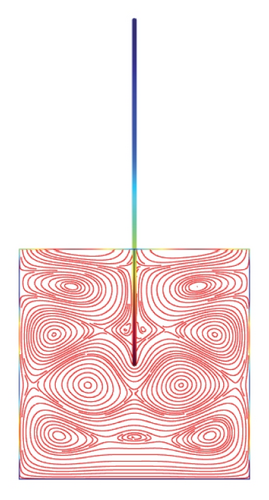
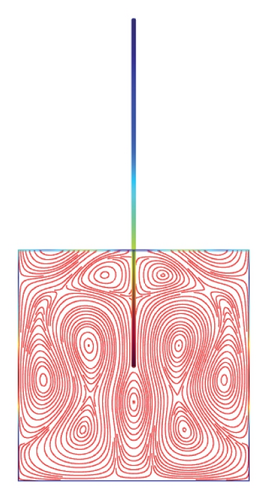



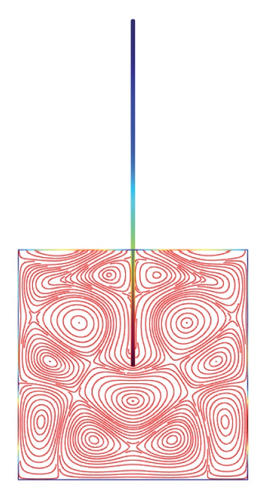
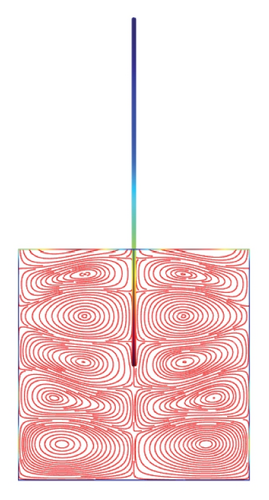
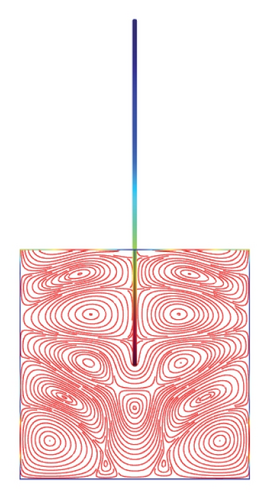

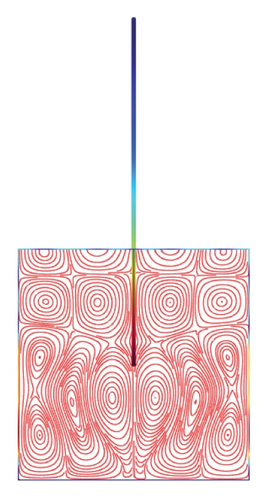
4. Conclusion
This paper has presented an analytical method to understand the modal behavior of beams partially immersed in a viscous fluid. The validity of the present solution is solidly confirmed numerically. The main application of the proposed method is in characterization of rheological properties of viscous materials [16]. In addition the study can be also extended further for the optimization tool for complex engineering design problems.
Conflict of Interests
The authors declare that there is no conflict of interests regarding the publication of this paper.




